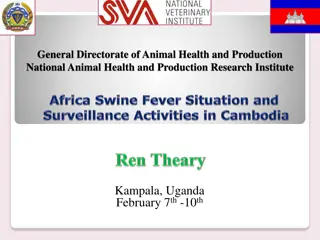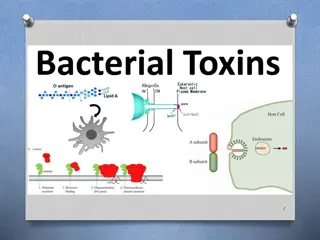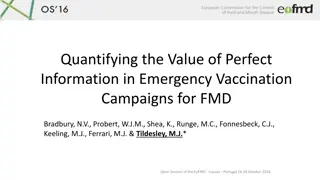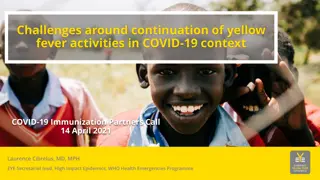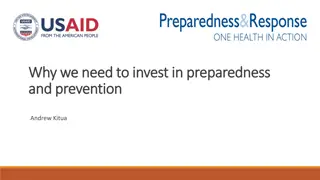ASF Outbreak Surveillance and Control Strategies in Cambodian Pig Farming
An overview of the African Swine Fever (ASF) outbreak in Cambodia, highlighting the detection of outbreaks in various provinces, outbreak containment efforts, common pig diseases in Cambodia, surveillance objectives, and sampling methods for ASF detection in pigs. The initiative aims to prevent ASF
0 views • 20 slides
Avian Influenza Overview and Outbreak History in South Africa
Avian Influenza, specifically Highly Pathogenic Avian Influenza (HPAI) outbreaks in South Africa, have been documented since 2004, affecting primarily ostriches and poultry. Wild bird transmission remains a concern, with risk factors such as rainfall, temperature, wetlands, and poultry movements con
2 views • 25 slides
Building Resilience Against Cholera Outbreaks: Lessons from IHR Framework
Exploring how the International Health Regulations (IHR) can enhance preparedness and response to cholera outbreaks. Discusses the functional components of IHR, the role of National IHR Focal Points, and best practices in building resilience. Highlights the importance of coordination, communication,
2 views • 20 slides
Understanding Bacterial Toxins and Cell Damage
Bacterial toxins are poisonous substances produced by microbes that can cause harm to host cells through direct damage, toxin production, and hypersensitivity reactions. Toxigenesis is a crucial mechanism used by bacterial pathogens to induce disease, with endotoxins and exotoxins playing distinct r
2 views • 28 slides
A Look Into Cholera Control and WASH Services Worldwide
The World Health Organization, along with the Global Task Force for Cholera Control, is focusing on analyzing reported cholera cases from 2010-2021 and the levels of water, sanitation, and hygiene (WASH) services in various countries. The report highlights the importance of basic WASH services in pr
3 views • 9 slides
Comprehensive Overview of Continuity of Business in FAD Outbreaks
Continuity of Business (COB), also known as managed movement, is a crucial strategy that allows the movement of non-infected animals and non-contaminated animal products during a Foreign Animal Disease (FAD) outbreak. This approach helps maintain normal business operations in agriculture and food in
4 views • 27 slides
Anaerobic Bacterial Infections: Overview and Clinical Implications
Anaerobic bacterial infections are caused by bacteria that do not require oxygen for growth, posing challenges in diagnosis and treatment. This article delves into the types of anaerobic bacteria, their role in human infections, and common clinical presentations such as abscess formation. Gram-negat
2 views • 24 slides
Epidemiology Investigation and Response in FAD Outbreaks
This presentation covers the phases of epidemiological investigation in Foreign Animal Disease (FAD) outbreaks, including the descriptive, analytic, and intervention phases. It discusses the collection of information, diagnostic testing, disease risk factors, associations, and identifying the FAD ag
1 views • 14 slides
Understanding Bacterial Physiology and Growth
Bacterial physiology encompasses the growth, nutrition, and metabolism of bacteria. Bacterial growth involves binary fission, generation time, colony formation, and is influenced by various factors such as temperature, atmosphere, moisture, and radiation. Understanding the classification based on te
0 views • 33 slides
Exploring Bacterial Flagella: Structure and Function
Bacterial flagella are long, thin appendages crucial for motility in bacteria. Composed of filament, basal body, and hook, these structures play a vital role in bacterial movement. This article dives into the detailed structure and functionality of bacterial flagella, highlighting their importance i
0 views • 9 slides
Understanding Bacterial Locomotion: Flagellar Structure and Movement Mechanism
Bacterial locomotion involves intricate flagellar structures composed of filaments, basal bodies, and hooks. The synthesis of flagella is a complex process controlled by numerous genes. The rotation of the flagellar helix acts as a motor, determining the direction of bacterial movement.
1 views • 12 slides
Understanding Bacterial Photosynthesis: Types and Processes
Photosynthesis is the conversion of light energy into chemical energy, crucial for growth and production of ATP. Prokaryotes such as cyanobacteria, purple and green bacteria, and halobacteria demonstrate different forms of photosynthesis. Oxygenic photosynthesis, found in cyanobacteria, releases oxy
2 views • 20 slides
Introduction to Phage DNA Integration in Bacterial Cells
Phage DNA can be introduced into bacterial cells through two methods: transfection and in vitro packaging. Transfection involves mixing purified phage DNA with competent E. coli cells, inducing DNA uptake via heat shock. In vitro packaging utilizes proteins coded by the phage genome, which can be pr
1 views • 13 slides
Bacterial Culture Transfer Techniques and Growth Indicators
Bacterial cultures can be transferred using aseptic techniques to ensure purity. Growth indicators such as turbidity in liquid media and colonies on agar plates signify microbial growth. Proper sterilization and handling of instruments are crucial in the process. Techniques like streaking on agar pl
1 views • 4 slides
Implementation of nOPV2 for cVDPV2 Outbreak Response
Circulating Vaccine-Derived Poliovirus (cVDPV) outbreaks, particularly cVDPV type 2 (cVDPV2), have increased in recent years. The novel oral polio vaccine type 2 (nOPV2) is an innovative tool developed over nearly 10 years to combat these outbreaks. Clinical trials have shown that nOPV2 provides com
0 views • 18 slides
Understanding Bacterial Spore Survival and Thermal Death Rates
Survival of bacterial spores during heat processing is crucial for food safety. The concept of Decimal Reduction Time (D value) and Thermal Death Time (TDT) curve help in understanding the thermal destruction of bacteria or spores. The Z value indicates the change in temperature necessary to cause a
6 views • 14 slides
Epi-Ready: Investigating Foodborne Outbreaks & Epidemiologic Approaches
In Module 6 of the Epi-Ready Epidemiologic Investigation series, participants learn about epidemiologic approaches in responding to foodborne outbreaks. The module covers methods for information gathering, measures of association, statistical significance, case definitions, surveillance activities,
1 views • 41 slides
Understanding Bacterial Endospores and Sporulation Process
Bacterial endospores are dormant structures that allow bacteria to survive harsh conditions. They contain vital genetic material and are resistant to drought, heat, radiation, and chemicals. The process of sporulation involves the formation of endospores within bacterial cells, followed by germinati
0 views • 34 slides
Understanding Bacterial Taxonomy and Staining Techniques
Bacterial taxonomy involves classifying and identifying bacteria, while staining techniques such as Gram staining help differentiate between Gram-positive and Gram-negative bacteria. This article discusses the importance of distinguishing bacterial strains, preparing smears, and performing different
0 views • 17 slides
Understanding Cyclosporiasis Outbreaks in Georgia: A Comprehensive Overview
Explore the prevalence of Cyclospora outbreaks in Georgia from 2005 to 2015, including historical data, diagnosis methods, demographic insights, and notable past outbreaks linked to foodborne sources. Learn about the parasite Cyclospora cayetanensis, its symptoms, diagnosis challenges, and the cycli
1 views • 21 slides
Insights into the Plague: Epidemiology, Etiology, and Outbreaks
The Plague, caused by Yersinia pestis, has a chilling history spanning pandemics like the Justinian Plague and the Black Death. Understanding its etiology, family, and pathogenicity is crucial. This deadly disease has had notable outbreaks in India, emphasizing the importance of recognizing its host
0 views • 24 slides
Understanding Bacterial Growth and Reproduction in Microbiology
Bacterial growth involves binary fission where cells divide into two, leading to the formation of new cells. The generation time varies among species. The growth curve consists of lag, exponential, stationary, and death phases, each with distinct characteristics. By understanding these phases, resea
0 views • 15 slides
Understanding Bacterial Flagella: Structure and Function
Bacterial flagella, known as flagellum, are hairlike appendages responsible for swimming motility. They are composed of three parts - the filament, basal body, and hook. The filament is a hollow cylinder made of flagellin protein subunits. The synthesis of flagella involves multiple genes. This arti
0 views • 6 slides
Understanding Bacterial Colony Morphology for Microbiology Analysis
Bacterial colonial morphology plays a crucial role in identifying bacteria and fungi. This exercise focuses on recognizing the cultural characteristics of bacteria on agar plates through colony morphology. Each colony represents a genetically similar group of microorganisms derived from a single cel
1 views • 6 slides
Mechanisms and Role of Horizontally Transferred Genetic Elements in Bacterial Disease Pathogenesis
This presentation explores the transfer of foreign DNA into bacteria, discussing mechanisms such as conjugation, transduction, and transformation. It delves into the significance of Mobile Genetic Elements (MGEs) like plasmids, bacteriophages, and transposons in bacterial virulence and pathogenesis.
0 views • 20 slides
Understanding Bacterial Morphology and Simple Stain Techniques
Explore the characteristics of bacteria based on their shape and structure, grouped into spherical, rod-shaped, and helical types. Learn about bacterial smear preparation principles and the simple stain procedure for observing bacterial cells under a microscope. Discover various bacterial species an
0 views • 13 slides
Managing Uncertainty in Emergency Vaccination Campaigns for FMD
Exploring the value of perfect information and the dynamics of information analysis during disease outbreaks, particularly focusing on emergency vaccination for Foot-and-Mouth Disease (FMD). Addressing uncertainties surrounding FMD control, vaccine effectiveness, capacity, and optimal vaccination st
0 views • 25 slides
Challenges in Continuing Yellow Fever Activities Amid COVID-19
Challenges persist in sustaining yellow fever activities during the COVID-19 pandemic, with decreased surveillance, delayed outbreak responses, and logistical disruptions impacting efforts to eliminate yellow fever epidemics. The EYE partnership focuses on protecting at-risk populations, preventing
0 views • 9 slides
Evaluation of Petroleum Hydrocarbon Degraders in Wastewater Canal Supplemented with Organic Carbon Source
This study explores the potential of native bacterial populations in wastewater for bioremediation of petroleum hydrocarbon-polluted environments. The research involved exposing Bonny light crude oil to wastewater canal samples supplemented with dry maize cob as an organic carbon source. Results sho
0 views • 26 slides
Understanding E. coli O157:H7 Outbreaks and Investigations
Explore the characteristics, pathotypes, serotypes, and lifestyle of E. coli O157:H7, a dangerous pathogen responsible for outbreaks linked to various food sources. Discover its growth conditions, toxins, symptoms, and ways it contaminates food, leading to public health concerns and investigations.
0 views • 16 slides
Insights into Salmonella Bacteria and Outbreaks
Salmonella is a Gram-negative, rod-shaped bacterium that is commonly found in food and can cause infections in humans. It belongs to the Enterobacteriaceae family and has various subspecies with different characteristics and serovars. Understanding its nomenclature, growth characteristics, and commo
0 views • 19 slides
Outbreak Investigation and Management in Public Health
Outbreak investigation is crucial in understanding, distinguishing, and managing disease outbreaks. This involves identifying the nature of outbreaks, studying key terms like endemic and epidemic, and examining outbreak settings such as food-borne and water-borne scenarios. By investigating outbreak
0 views • 53 slides
Public Health Events in WHO Africa Region: Outbreaks Overview
Public health events in the WHO Africa Region pose a significant threat to global health security, with frequent outbreaks of diseases like Ebola, Yellow Fever, Polio, and cholera. In 2015, 105 public health events were reported, the majority being infectious diseases. Ongoing outbreaks in Angola, D
2 views • 30 slides
Importance of Investing in Preparedness and Prevention to Address Outbreaks and Pandemics
Investing in preparedness and prevention is crucial to mitigate the devastating impacts of outbreaks, epidemics, and pandemics. Preparedness helps identify gaps in systems and enhance vigilance, while prevention allows for effective interventions to minimize risks and save resources, ultimately prom
0 views • 11 slides
Understanding Gram Staining in Bacterial Identification
Gram staining is a crucial technique in identifying bacterial organisms, developed by Hans Christian Gram. It involves differentiating bacteria into gram-positive and gram-negative groups based on cell wall properties. Gram staining has five basic steps and helps in determining bacterial characteris
0 views • 15 slides
Managing MDR Gram-negative Enterobacteriaceae Outbreaks in Hospitals: Response Strategies and Best Practices
Hospitals face a growing threat from multidrug-resistant Gram-negative bacteria, such as Acinetobacter baumannii and Klebsiella pneumoniae. This article discusses the emergence of carbapenem-resistant Enterobacteriaceae in Europe and outlines response strategies, including lab screening, communicati
0 views • 23 slides
Investigating Foodborne Illness Outbreaks Linked to Events
An organization is investigating outbreaks of foodborne illnesses associated with two different events: a wedding in Pueblo and the National Western Stock Show. The wedding outbreak involves confirmed cases of Norovirus, affecting several guests, while the stock show outbreak is linked to E. coli O1
0 views • 16 slides
Bacterial Conjugation: Mechanism and Applications
Bacterial conjugation is the process of transferring genetic material between bacterial cells through direct contact or bridge-like connections. Discovered in 1946, this mechanism enables the transfer of DNA regions between various bacterial species, including Gram-negative and Gram-positive bacteri
0 views • 58 slides
Understanding Influenza: From Pandemics to Avian Flu Outbreaks
Influenza is a viral respiratory illness that can range from seasonal flu to pandemic outbreaks like the 2009 swine flu (H1N1) epidemic. The dangers and prevention methods of specific strains, such as H5N1 avian flu, have been witnessed since 2003. This summary delves into the characteristics, impac
0 views • 13 slides
Bacterial Cell Shapes and Simple Stain Procedure
Explore the three basic shapes of bacterial cells - Coccus, Bacillus, and Spiral - and learn about different arrangements within each shape. Dive into the Simple Stain procedure, a straightforward staining technique using single stains like methylene blue and crystal violet, to prepare and visualize
0 views • 32 slides
